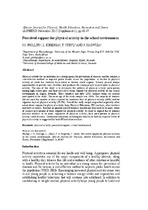Perceived support for physical activity in the school environment
Abstract
Physical activity for an individual is a strong means for prevention of diseases and for nations, a cost-effective method to improve public health across the population. A decline in physical activity of youth has however been noted in various world regions. Schools present unique
opportunities to provide time, facilities and guidance for young people to participate in physical activity. The aim of this study is to determine the patterns of physical activity participation among high school girls and their perceived social support for physical activity in the school
environment in Kigali, Rwanda. Three hundred and fifty (350) learners from six schools participated in the study. The mean age of the study sample was 16.06. The majority of learners did not meet the number of days required for moderate days of physical activity (66%) and for
vigorous days of physical activity (70.9%). Overall the study sample responded negatively when asked about support for physical activity from Physical Education (PE) teachers, other teachers and boys at school. Teachers in general and PE teachers specifically thus need to be more aware of learners perceptions of their support for physical activity. It could be argued that if learners perceive teachers to be more supportive of physical activity, their participation in physical activity could increase. Continuous education including the benefits of and the required levels of physical activity is suggested for both PE and other teachers.

